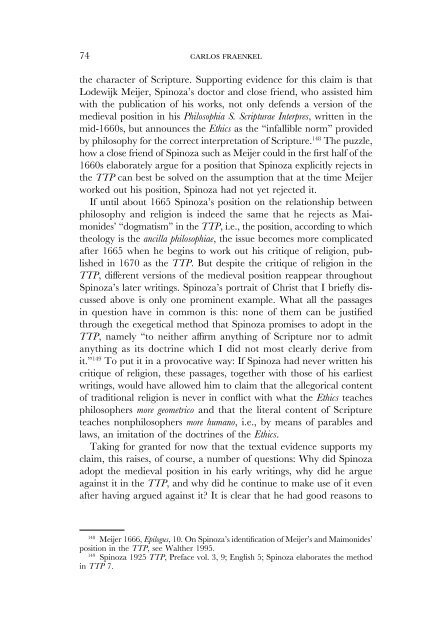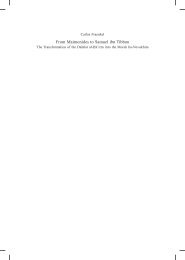Download PDF - Carlos F. Fraenkel
Download PDF - Carlos F. Fraenkel
Download PDF - Carlos F. Fraenkel
You also want an ePaper? Increase the reach of your titles
YUMPU automatically turns print PDFs into web optimized ePapers that Google loves.
74 carlos fraenkelthe character of Scripture. Supporting evidence for this claim is thatLodewijk Meijer, Spinoza’s doctor and close friend, who assisted himwith the publication of his works, not only defends a version of themedieval position in his Philosophia S. Scripturae Interpres, written in themid-1660s, but announces the Ethics as the “infallible norm” providedby philosophy for the correct interpretation of Scripture. 148 The puzzle,how a close friend of Spinoza such as Meijer could in the first half of the1660s elaborately argue for a position that Spinoza explicitly rejects inthe TTP can best be solved on the assumption that at the time Meijerworked out his position, Spinoza had not yet rejected it.If until about 1665 Spinoza’s position on the relationship betweenphilosophy and religion is indeed the same that he rejects as Maimonides’“dogmatism” in the TTP, i.e., the position, according to whichtheology is the ancilla philosophiae, the issue becomes more complicatedafter 1665 when he begins to work out his critique of religion, publishedin 1670 as the TTP. But despite the critique of religion in theTTP, different versions of the medieval position reappear throughoutSpinoza’s later writings. Spinoza’s portrait of Christ that I briefly discussedabove is only one prominent example. What all the passagesin question have in common is this: none of them can be justifi edthrough the exegetical method that Spinoza promises to adopt in theTTP, namely “to neither affirm anything of Scripture nor to admitanything as its doctrine which I did not most clearly derive fromit.” 149 To put it in a provocative way: If Spinoza had never written hiscritique of religion, these passages, together with those of his earliestwritings, would have allowed him to claim that the allegorical contentof traditional religion is never in conflict with what the Ethics teachesphilosophers more geometrico and that the literal content of Scriptureteaches nonphilosophers more humano, i.e., by means of parables andlaws, an imitation of the doctrines of the Ethics.Taking for granted for now that the textual evidence supports myclaim, this raises, of course, a number of questions: Why did Spinozaadopt the medieval position in his early writings, why did he argueagainst it in the TTP, and why did he continue to make use of it evenafter having argued against it? It is clear that he had good reasons to148Meijer 1666, Epilogus, 10. On Spinoza’s identification of Meijer’s and Maimonides’position in the TTP, see Walther 1995.149Spinoza 1925 TTP, Preface vol. 3, 9; English 5; Spinoza elaborates the methodin TTP 7.



